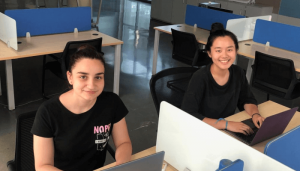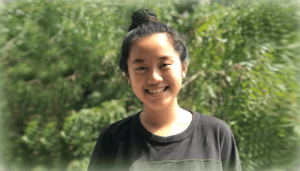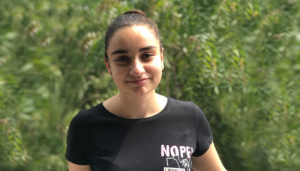From visiting the Chowmahalla Palace and the Charminar to walking alongside the Hussain Sagar, from eating Hyderabadi biryani to craving for the deep-fried potato served for Friday lunches at the mess, from riding the Metro to taking the ubiquitous Uber, from dabbling in tennis on campus to checking out Cult. Fit, these young MIT interns have been there, done that and some more. Let’s find out what brings 19-year-olds Yu Jing Chen and Tamara Mitrovska from MIT to the IIITH campus this Summer break.
Come Summer and motivated undergrads typically seek internships in companies or other research-related positions. 19-year-old MIT undergrads Yu Jing Chen and Tamara Mitrovska are no different. Except that after their freshman year, they were on the lookout for an international internship. Luckily for them, MIT has an international education program titled the MIT International Science and Technology Initiatives (MISTI). It facilitates international faculty collaborations with leading research institutes, companies and universities around the world. And for MIT students, it also matches them with internships and research opportunities of their interest globally. With a partnership that spans over 28-odd countries, MISTI Programs offer interested students unique international learning experiences.

Immersion vs. Casual Tourism
Both Yu Jing and Tamara specifically chose the MISTI-India program, terming the country’s rich culture as the deciding factor in making their choice. “Not many people get such an opportunity to experience that, especially in their college years. So I chose India instead of another western country because I thought it would be easier to immerse myself in those (western) cultures in future years by myself as a tourist. But you would get a completely different experience as a tourist over here. You would not be able to immerse yourself into this culture without actually living and being with people here ..and having people forced to talk to you!” laughs Yu Jing.
The IIITH Partnership
Professor Vasudeva Varma who heads IREL speaks of the partnership with the MISTI-India program by recalling how it all began 3 years ago. “There was a former student of Chirec who specifically asked to be placed in our lab, which was when the program coordinator reached out to us for the first time.” The internship proved to be so fruitful that it led to a publication of a research paper based on her work here. It helped to spread the word about the institute in general and the lab in particular. Since then every year, IIITH has been approached by MIT students particularly interested in Computer Science, AI or other tech-related research.
Applications of NLP
The two interns are students of Computer Science at MIT albeit with different majors. Yu Jing has chosen Urban Studies and Planning while Tamara is pursuing Engineering. When they knew India was going to be their destination, they further selected the International Institute for Information Technology Hyderabad based on the description of the projects listed here. They were particularly interested in the project that was described on the Information Retrieval and Extraction Lab’s (IREL) website. “I’m very interested in topics like biases and social justice and applying technology for making social impact,” says Yu Jing, the more vocal of the two girls. For Tamara, it was more of experiencing and learning different things.

Project Angel
Studies have shown that teenage girls in high school are prone to depression. In a bid to identify such vulnerable teens who may need the right kind of intervention, the IREL recently kicked off a multi-disciplinary project titled Project Angel in collaboration with social scientists and others. While the aim of Project Angel is to help in detecting online toxic content that can affect the teens, there are a number of mini projects going on in tandem towards the goal, much like pieces to a bigger puzzle. The girls were assigned to two teams working on different aspects of social media. “I was looking at a way to classify body shaming posts from other content to Instagram. So the first thing I did here, was to make an Instagram scraper to collect posts from Instagram. And then we had to divide the posts into body shaming and other content. I spent most of my time here in creating a classifier that searches for and downloads posts, checking if they relate to body shaming or not,” explains the soft-spoken Tamara. She adds that she had to analyze what parts of the body are being used in those shaming posts.

Before the internship comes to an end, her next task is to create a web demo that will visually demonstrate how the classifier works. Somewhat similar to Tamara’s work, Yu Jing’s team has been working on a Twitter scraper. “I learned a lot about natural language processing since I hadn’t done any of that before. What I’m working on is style transferring tweets into a single instagram post. I had to take tweets on a topic, summarize them and generate an Instagram post about them. The broader application for that is to summarize useful information found on Twitter and generate a single Instagram post from that,” says Yu Jing. Why Instagram? “Instagram is the main channel of use for a lot of teenagers today,” they say in unison.
Incredible India
Interns selected through the MISTI programs are typically given orientation sessions to familiarize them with culture, society and workplace norms of the host country. Nevertheless, Tamara who is an international student from Macedonia at MIT, had to convince her family before they were okay with the idea of her coming to India. “But now they see everything is fine. So they’re ok with it,” she says. Yu Jing had a similar reaction at home. “I had to tell them (family) it’s paid for!” But she adds seriously that it was mainly their concerns about being a woman in India due to the bad press received over the years. “I feel like it’s worse in the US. (Of course) It may be that I’ve mainly gone to places with other people and never alone. In the US there are people who catcall you on the streets…I feel like the men are pretty respectful out here. They call you ma’am!” she exclaims with a laugh.
They’ve done the regular tourist circuit of the city and are well versed with the Hyderabad of the Nizam’s era as well as the spanking new address of the Financial District. Sadly for the biryani aficionados, neither of the girls has taken a fancy to the iconic Hyderabadi dish. “We’ve eaten biryani at Paradise, and even at the mess. But there’s a certain spice in it that we don’t like that much. Unfortunately we don’t know what that spice is”.
Life at IIITH
Interacting with students not just from all over India but from the South Asian region came as an unexpected surprise for the girls. They are all praise for not just other team members of the project who went out of their way to help them settle in, but also their mentor Prof. Vasudeva Varma who heads the IREL. “Prof. Varma is awesome. He is very nice and checks in on us, outside of the project as well, and helps us when we catch a sickness or something,” they say with gratitude. When they first landed here, Hyderabad was in the throes of a harsh Summer. “It was very hot then and there was no air conditioning in the hostel. But it is fine now,” they say nonchalantly.
iDiplomat
Yu Jing who hails from Chicago doubles up as an MIT Innovations Diplomat. The program which builds on an existing global one such as MISTI aims to equip students with knowledge and tools they can use in preparation for their global activities while on the summer internship and later in their careers as innovators.“I am looking into innovation in India and learning more about the issues and benefits when it comes to innovation and entrepreneurship that are inherent to Hyderabad, whether that be due to location or government and so on,” she explains. Coming to IIITH couldn’t have been a better choice for her with the physical presence of not one but two startup incubators on campus – the Centre for Innovation and Entrepreneurship (CIE) and the THub. As a girl in STEM, Yu Jing has also been in talks with several people to see how women are being represented in the entrepreneurial space here. Discovering that the government has established a space dedicated to women entrepreneurs called the WEHub, she calls it a welcome beginning.
Bright Minds
Having these interns here has been fantastic, says Prof. Varma. “They bring in a completely different perspective, thinking from the first principles as opposed to incremental thinking.” Speaking of how incredibly bright they are, Prof. Varma says that by stepping out of the confines of the tech world, they are constantly on the lookout for societal problems and finding solutions to them. He mentions that Yu Jing had maxed her CGPA score of 5.0 at MIT. Tamara too is a brainiac, participating in the International Maths Olympiad since the age of 16. Her name is on the IMO Wall of fame. “I was always into Math from the beginning but not so much anymore. I want to try out new things now,” she says shyly. Passionate about empowering girls in STEM from her high school days, Yu Jing led a club called the Mathematigals. The club went to different schools in Chicago weekly, to teach Math in fun and non-typical ways to 2nd-4th grade girls. “We wanted to empower them at a young age before self-confidence and interest in STEM typically drops in girls according to studies,” she says. Even now as a freshman at MIT, she is the coordinator of a mentorship program for high school students in the greater Boston area. It involves homework help, explaining lessons, helping out with college admission process such as writing essays, filling out forms and so on.
With such enthusiasm, and potential, one can only expect great things from these young sparks. The world is their oyster. We wish them luck for their bright future while hoping they got the immersive experience they wished for!


